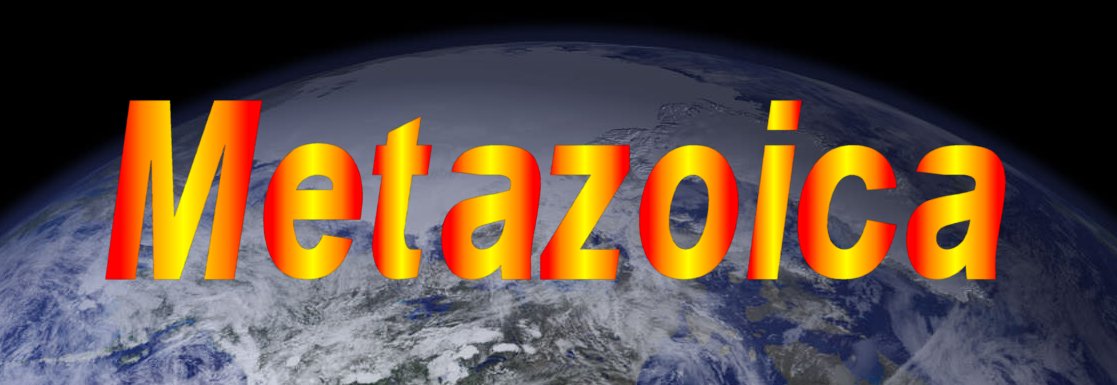Welcome to my Metazoic site! This site discusses the existence of the creatures to come along after humans will be extinct. I first became interested in a world after man when I acquired my first copy of Dougal Dixon's After Man: A Zoology of the Future in 1992. However, I unwittingly created creatures that did not exist from the time I was about 8 years old. But it was after I obtained a copy of that book (now a collector's item) that I decided to take these same creatures I created as a child and make them more realistic in an evolutionary sense. Though it may be hard for a lot of us to grasp, humans will soon become extinct. One of the biggest factors of how this will happen is the current overpopulation rate. Which is why I don't contribute to the population. I created this world with little more than mammals fulfilling all ecological niches with the help of some friends. I even gave the era of the age after man a name, I called it the Metazoic, derived from the words for "After-era" (Meta, meaning after, and zoic meaning era). We are now in the Cenozoic era. To view all the animals I have created since I began this project, you can go to the "Meet the Mammals" section of this site. To discuss your own ideas about what you think will happen in the future world, and share your ideas with others, please feel free to leave a comment.
One more thing, some of you may find this site quite offensive, and you have a right to your own opinion. But please respect my right to have an opinion too. I'm not saying there is no GOD, I believe it was HIM who got the ball rolling. But I believe after that, evolution took over. There is so much more evidence of evolution than there is of creation. Even that going on right under our noses. Other than that, enjoy yourself and visit our many links.
Tuesday, November 30, 2010
Family of the Week: The Ruonids
The sub-family Regniinae differ from other species by being bipedal walkers. Regnium, for example, walks bipedally all the time. It is a terrestrial hunter that habitually feeds on antelope, monkeys, lemurs, rodents, and anything else it can capture. Stolidus is a rabbit-sized animal that lives mostly in the trees, clinging to the branches with sharp, curved, retractable claws. The tail is long and thick, but it is not prehensile. Though sometimes when the animal it's self is a rest, it will curl it's tail up under it's self, or sometimes even twist it around a vine, more like a twist-tie than like a second hand. They move slowly with all four limbs in the trees, but when on the ground, they move only on their hind legs, and in a quicker motion than they use in the trees. They move more like armadillos walking fast on the ground, with their forelegs tucked under their torso. Stolidus is mostly insectivorous. They favor the meat of beetles, cicadas, grubs, spiders and cockroaches. They also will feed on bird eggs, fledgelings, small bats, and tree-dwelling rodents. Regnium is mostly a product of the early Metazoic, while Stolidus is a mid-to-late Metazoic period genus.
The sub-family Ruoninae is quite different from the Regniinae. These are the truly dog-like species, that move about on all fours. Though some are capable of walking on their hind legs for short periods, they are not true bipeds like the Regniinae. This is a very varied sub-family. Ruo is the one species that very closely resembles a modern wolf. Though it is slightly larger. They are pack hunters, designed to bring down animals up to the size of a young gigantelope. They do not have retractable claws or the strength to hold down a large animal like that. They kill their prey by eating it.
The most remarkable species in this group are also within this subfamily. Utrarius is one of them. This animal is a desert dweller. The females are equipped with a sack that stores water that she can bring home to her helpless babies. The babies are often kept in a nest, so when the mother leaves to hunt, she covers the nest with whatever she can find. And she will store water in this water pouch to give to her babies that are not old enough to follow her to the watering hole, yet are too old to suckle. Another fascinating species are of the genus Naiadis. These animals live in rivers and streams. The body is much like an otter's but the head and neck is a lot like a heron's. These animals are good swimmers. They also use their head and neck to snatch at prey. They sit very still, sometimes for hours, in the shallow water, watching the surface for fish and any other aquatic creatures, such as shrimp and other crustaceans. When something edible swims beneath them, they shoot their head in and snatch the prey. The legs are very short, and really only good for swimming. They cannot move too well over land.
Though these animals are predatory, they also have their own set of enemies to beware of. Deinognathids and dogs are their main predators. While Deinognathids will prey on any of the species, dogs mostly concentrate on the smaller animals. These animals can defend themselves by inflating and looking bigger. They snarl and growl as well to appear more menacing. The jaws and claws can inflict some harsh wounds. The females with young are naturally more aggressive. Though little can be done to deter a large, hungry Deinognathid.

1 comment:
U r right.U know i always imagined how dinosaurs would looked like and i also got little scared ever.Your article recalled me that all.Its interesting to study about non-existent animals.
Post a Comment